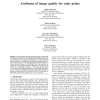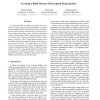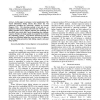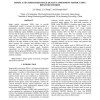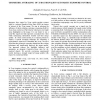101
click to vote
JEI
2010
14 years 7 months ago
2010
The evaluation of perceived image quality in color prints is a complex task due to its subjectivity and dimensionality. The perceived quality of an image is influenced by a number ...
130
Voted
CVPR
2011
IEEE
14 years 8 months ago
2011
IEEE
It is often desirable to evaluate an image based on its quality. For many computer vision applications, a perceptually meaningful measure is the most relevant for evaluation; howe...
121
click to vote
ICIP
2009
IEEE
14 years 10 months ago
2009
IEEE
An improved blind image quality assessment scheme that is based on the Watson's just noticeable difference (JND) modulated spread spectrum watermarking, is proposed. For the ...
140
click to vote
HIS
2009
14 years 10 months ago
2009
In this paper, we propose a vector quantization (VQ) -based information hiding scheme that cluster the VQ codeowrds according the codewords' relation on Voronoi Diagram (VD). ...
118
Voted
ICIP
2010
IEEE
14 years 10 months ago
2010
IEEE
Image quality assessment (IQA) aims to provide computational models to measure the image quality in a perceptually consistent manner. In this paper, a novel feature based IQA mode...
101
Voted
ICIP
2010
IEEE
14 years 10 months ago
2010
IEEE
Improper dose control in X-ray cardio-vascular systems leads to a reduced Signal-to-Noise Ratio (SNR) in regions of interest of the X-ray image. We aim at reducing the influence o...
98
Voted
MAMMO
2010
Springer
14 years 11 months ago
2010
Springer
Recently, detective quantum efficiency (DQE) arising from the concept of signal-to-noise ratio (SNR) has been used for assessing digital x-ray imaging systems. Using a phase-shift ...
111
click to vote
JEI
2010
14 years 11 months ago
2010
The mainstream approach to image quality assessment has centered around accurately modeling the single most relevant strategy employed by the human visual system (HVS) when judging...
84
Voted
CGF
2005
15 years 14 days ago
2005
To improve image quality in computer graphics, antialiasing techniques such as supersampling and multisampling
120
click to vote
PRL
2006
15 years 15 days ago
2006
Tree-Structured Vector Quantization (TSVQ) is a highly efficient technique for locating an appropriate codeword for each input vector. The algorithm does not guarantee that the sel...
